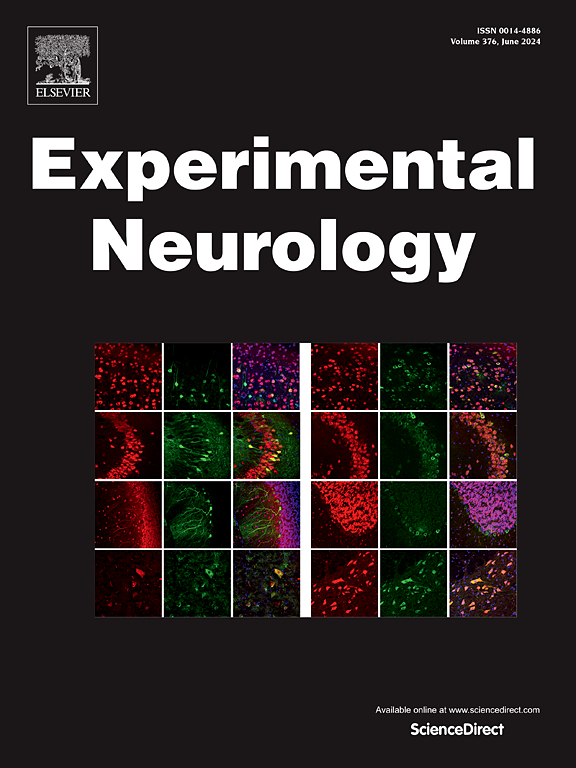在脑卒中小鼠模型中,法舒地尔通过抑制NLRP3/Caspase-1/GSDMD信号通路,减轻糖尿病相关认知能力下降,增强神经保护作用
IF 4.6
2区 医学
Q1 NEUROSCIENCES
引用次数: 0
摘要
2型糖尿病和肥胖症是进行性代谢紊乱,在治疗选择有限的缺血性卒中后,会增加不良结局和认知能力下降的风险。先前的研究表明,法舒地尔(一种RhoA激酶抑制剂)对多种神经系统疾病有治疗作用;然而,目前尚不清楚法舒地尔是否对缺血性脑卒中后的糖尿病性脑病提供神经保护。本研究旨在探讨法舒地尔对高脂饮食-链脲佐菌素(HFD/STZ)小鼠光血栓性卒中后糖尿病性脑病实验模型的保护作用,以评估行为结果和分子分析。实验小鼠通过眼眶后注射玫瑰(15 mg/kg)进行光血栓性卒中(pt-MCAO)手术,然后在532 nm激光照射下对大脑近中动脉照射4分钟。结果表明,法舒地尔治疗可为脑卒中后HFD/STZ小鼠提供潜在的神经元保护和改善行为结果。此外,法舒地尔抑制脑卒中后HFD/STZ小鼠的nod样受体蛋白3 (NLRP3)炎症小体及其组分,通过调节突触标记物增强认知功能,并显著减少神经炎症。法舒地尔还通过调节Bax和裂解的PARP-1蛋白表达,减少tunel阳性细胞的数量,显著降低氧化应激和细胞凋亡。综上所述,法舒地尔治疗可通过预防脑卒中后HFD/STZ小鼠的氧化损伤和NLRP3炎性体激活来提供神经保护和增强认知功能。这些结果表明,法舒地尔可能作为一种有希望的替代治疗候选人,以改善卒中预后和解决当前治疗方案的局限性。本文章由计算机程序翻译,如有差异,请以英文原文为准。

Fasudil mitigates diabetes-associated cognitive decline and enhances neuroprotection by suppressing NLRP3/Caspase-1/GSDMD signaling in a stroke mouse model
Type 2 diabetes mellitus and obesity are progressive metabolic disorders that heighten the risk of negative outcomes and cognitive decline after an ischemic stroke with limited treatment options. Previous research has shown that Fasudil, a RhoA kinase inhibitor, has therapeutic benefits in various neurological diseases; however, it is unknown if Fasudil provides neuroprotection in diabetic encephalopathy after ischemic stroke. This study aimed to explore the protective effects of Fasudil in an experimental model of diabetic encephalopathy following a photothrombotic stroke using high-fat diet-streptozotocin (HFD/STZ) mice to assess behavioral outcomes and molecular analysis. The experimental mice underwent photothrombotic stroke (pt-MCAO) surgery by retro-orbital injection of Rose Bengal (15 mg/kg), followed by 4 min exposure of the proximal-middle cerebral artery to a 532 nm laser exposure. The results indicated that Fasudil treatment provided potential neuronal protection and improved behavioral outcomes in post-stroke HFD/STZ mice. Additionally, Fasudil inhibited NOD-like receptor protein 3 (NLRP3) inflammasomes and their components, enhanced cognitive function by regulating synaptic markers, and significantly reduced neuroinflammation in post-stroke HFD/STZ mice. Fasudil also notably decreased oxidative stress and apoptosis by modulating Bax and cleaved PARP-1 protein expression and reducing the number of TUNEL-positive cells. In summary, Fasudil treatment offers neuroprotection and enhances cognitive function by preventing oxidative damage and NLRP3 inflammasome activation in post-stroke HFD/STZ mice. These results suggest that Fasudil may serve as a promising alternative therapeutic candidate for improving stroke outcomes and addressing the limitations of current treatment options.
求助全文
通过发布文献求助,成功后即可免费获取论文全文。
去求助
来源期刊

Experimental Neurology
医学-神经科学
CiteScore
10.10
自引率
3.80%
发文量
258
审稿时长
42 days
期刊介绍:
Experimental Neurology, a Journal of Neuroscience Research, publishes original research in neuroscience with a particular emphasis on novel findings in neural development, regeneration, plasticity and transplantation. The journal has focused on research concerning basic mechanisms underlying neurological disorders.
 求助内容:
求助内容: 应助结果提醒方式:
应助结果提醒方式:


